This is the only Egg Foo Young recipe you need. You can fill your omelet with any fillings you prefer and create a restaurant-style dish in your own kitchen!
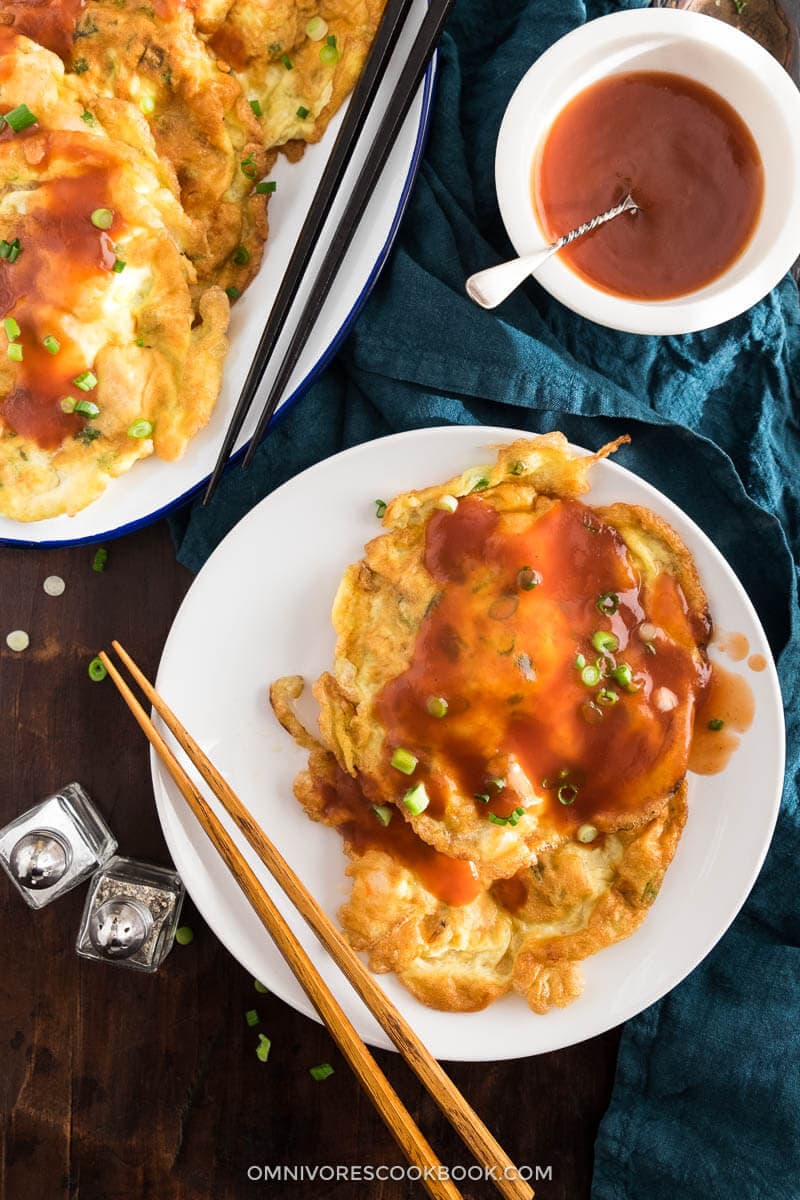
The first time I tried Egg Foo Young was in a small diner ran by Chinese immigrants in Cairo. It was quite different from the northern Chinese style omelet that I’d eaten growing up.
The omelet that I’m familiar with is usually filled with a single ingredient, either a green vegetable or a herb. For example, green onion, anaheim pepper, or young leaves of Chinese mahogany (xiang chun). Less oil is used in family-style cooking, and there is no gravy involved. The omelet is usually served with a simple congee, or with scallion pancakes and a bit of sweet bean paste.
The Cantonese style egg dish, or Egg Foo Young, is much more scrumptious. The eggs are usually mixed with a protein and several types of vegetables, such as ham, bean sprouts, bamboo shoots, and mushrooms, fried in oil until fluffy and crispy, and then served with a gravy.
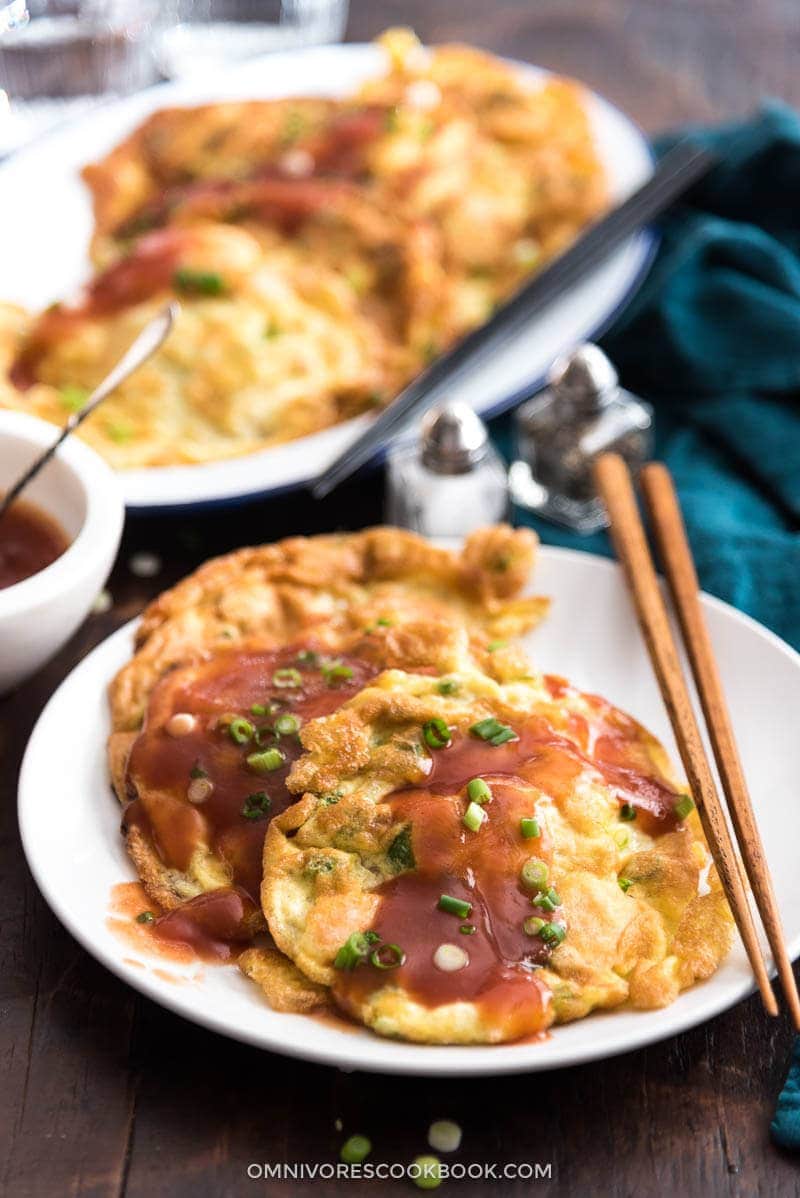
I love them both.
To make a good Egg Foo Young, you only need to note about one thing – less is more.
Just like the logic of pizza toppings, you should not attempt to fold too many ingredients into the eggs. You want the egg to bind all the ingredients together, with the main texture still tasting like egg. It is an omelet dish, after all, and not a vegetable stir fry.
To make a restaurant-style Egg Foo Young you need to use more oil.
Unlike the western style omelet, the Chinese version requires more oil and high heat to create the delightfully fluffy, crispy texture, and the beautifully browned surface. You’re actually overcooking the egg here. The additional oil will create bubbles in the egg mixture, which makes the texture very light.
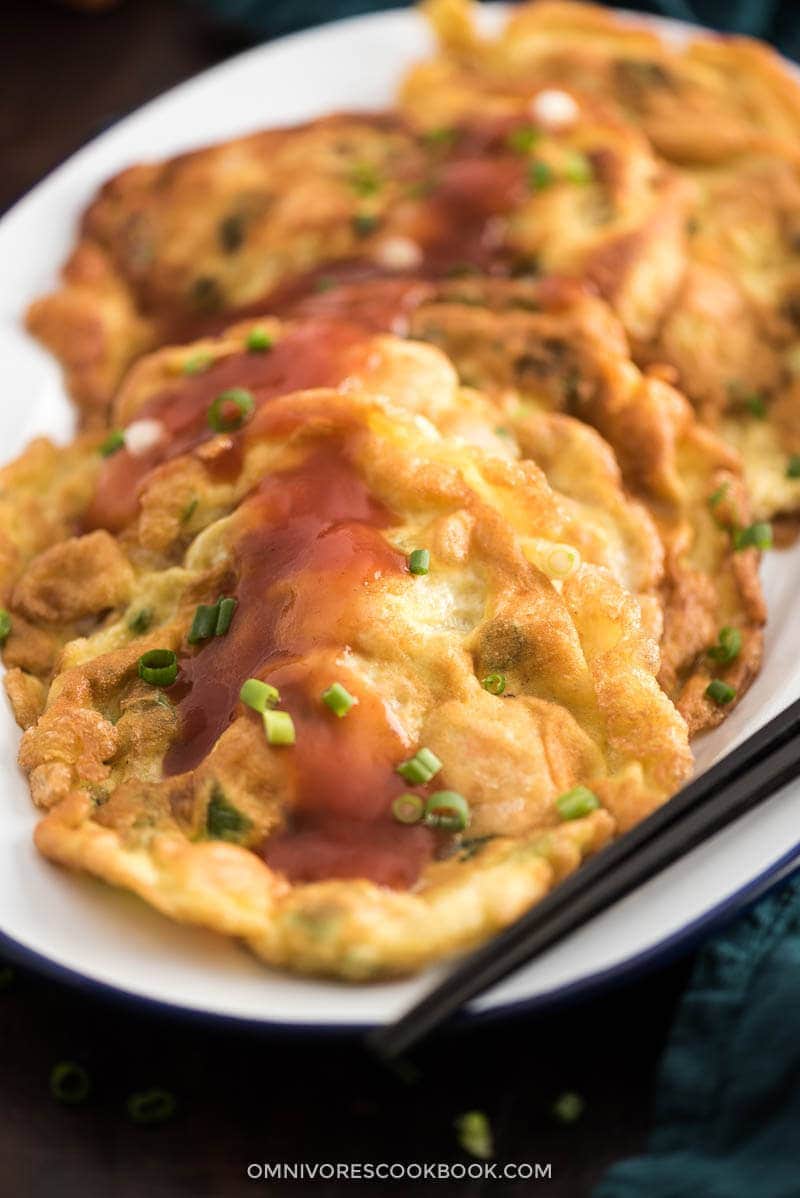
Although it doesn’t mean using tons of oil to deep fry the egg, you need to add enough oil to at least cover the bottom of a frying pan. A smaller size nonstick pan works great. I especially love my 7-inch omelet pan, which requires less oil and cook fabulous eggs.
If you heat up the pan properly, you will see that the eggs start to bubble immediately once you add the mixture into the pan. It only takes seconds for the bottom to set and brown.
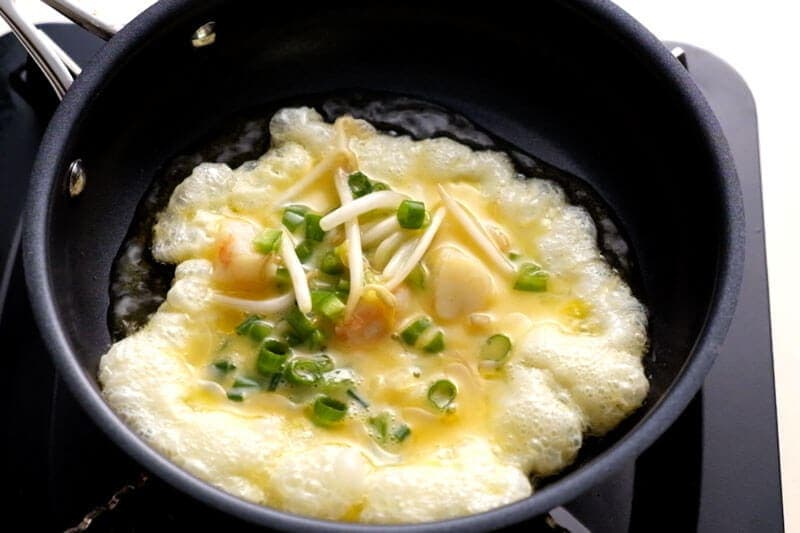
On the other hand, you definitely can use less oil to cook a healthier version. The texture will be different, but the flavor is still there.
The recipe below is my favorite combination, but you can replace the ingredients according to your preference.
My favorite protein for the filling is shrimp. You can replace it with any other protein, such as ham, char siu (Chinese BBQ pork), leftover chicken, or cooked ground meat. As for other vegetables, bean sprouts, bamboo shoot, and water chestnut add a crunchy texture. Green onions are a must for the flavor. Other ingredients such as spinach, peppers, cooked (or canned) mushrooms, cooked peas, sliced cabbage… they all work well in the omelet!
Again, remember that less is more. Do not overfill your omelet.
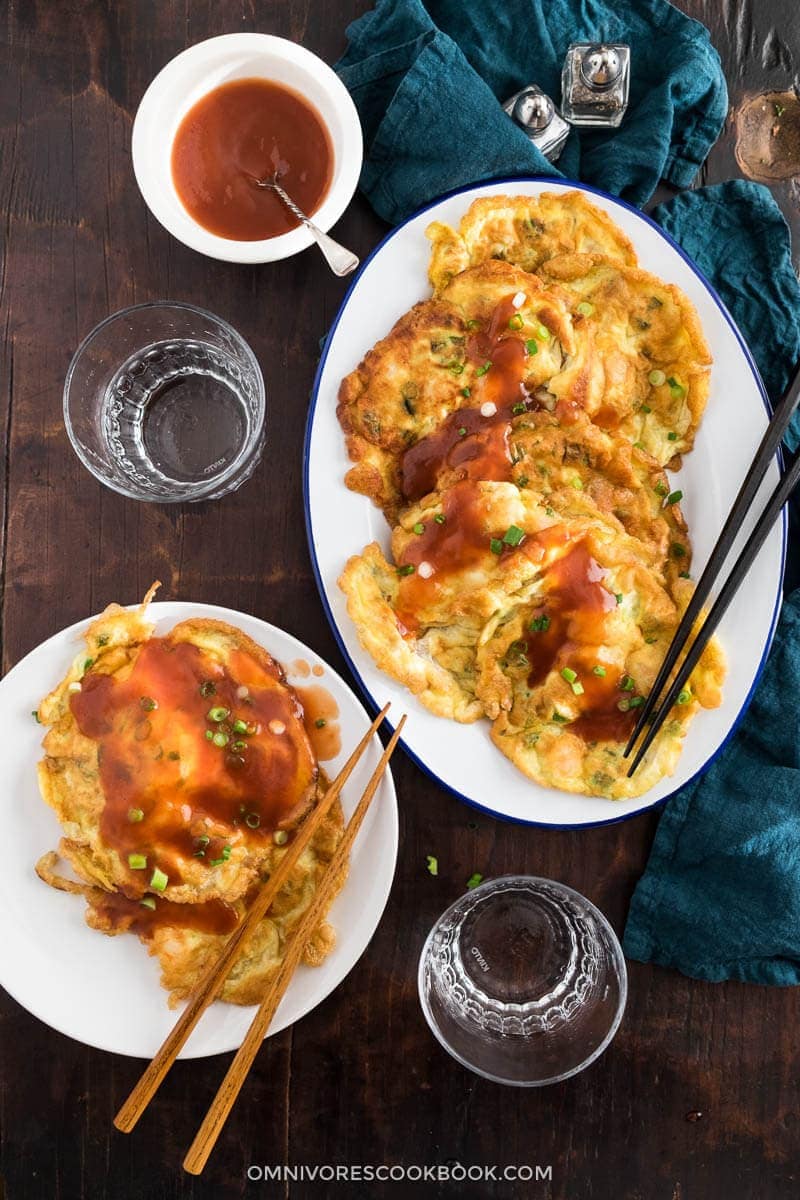
Want to learn more Chinese takeout recipes? Check these out:
- Chinese Beef and Broccoli with Tofu (One Pan Take-Out)
- Moo Goo Gai Pan
- General Tso’s Chicken
- Shrimp Fried Rice (扬州炒饭, Yang Zhou Chao Fan)
Happy cooking everyone!
If you give this recipe a try, let us know! Leave a comment, rate it (once you’ve tried it), and take a picture and tag it @omnivorescookbook on Instagram! I’d love to see what you come up with.
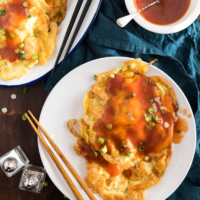
Shrimp Egg Foo Young (鲜虾芙蓉蛋)
Ingredients
Sauce
- 1/2 cup chicken broth
- 1/4 cup ketchup
- 1 tablespoon soy sauce
- 1 tablespoon rice vinegar (or apple cider vinegar)
- 1 1/2 tablespoon sugar
- 2 teaspoons cornstarch
Omelette
- 6 large eggs
- 1/3 cup bean sprouts
- 1 jalapeno pepper , sliced
- 2 green onions , finely chopped
- 1 cup shrimp , cooked and chopped
- 1/8 teaspoon salt
- 1/8 teaspoon white pepper powder
- 2 to 8 tablespoons vegetable oil *(Footnote 1)
Instructions
- Whisk together the Sauce ingredients in a saucepan over medium-low heat until the sauce simmers and thickens, about 5 minutes.
- Beat together the eggs, bean sprouts, green onions, shrimp, salt, and white pepper powder in a bowl until well-combined.
- Heat the oil in a skillet over medium heat, and scoop about 1/2 cup of the egg mixture into the skillet to make a patty.
- Fry until golden brown, about 4 minutes per side, and repeat with the remaining egg mixture. Set the patties aside.
- Spoon the sauce over the patties.
Notes
- To keep the egg fluffy, it requires more cooking oil. If you would like to use less oil that is fine but it will result in a flatter omelette.
Nutrition













Thank you for sharing this recipe. I made the Shrimp Egg Foo Young today and served it with Mandarin Pancakes. You didn’t specify the amount of garlic powder, so I guessed at 1/4 tsp. plus I added 3 diced white mushrooms. The end result tasted like it came from a restaurant. This is an excellent recipe and it’s so easy to make. Thanks again!!!
Hi Paul, you’re the most welcome I’m so happy to hear you tried out this dish! I love to serve them with Mandarin pancakes too. Yum!
I eat this a lot from a take out place back in college. Yours looks exactly the same. haha makes me feel so nostalgic
Maggie, what side would you serve with this dish? Thanks.
Hi Kim, you could serve this dish over rice or with mandarin pancakes. Happy cooking!
In the ingredient list for the egg foo young, sea salt and white pepper powder are listed but not mentioned in the instructions. Instead, garlic powder is mentioned but that’s not in the ingredient list. Ketchup is mentioned in the ingredient list for the sauce but it’s not in the instructions. I tried it both ways – with and without ketchup – and it tastes better without.
Hi Patricia, I’m sorry that my recipe was so sloppy and I forgot to mention so many ingredients in the instructions! I’m editing the post now to add them to the right place.
And thanks for your feedback on the ketchup. Most of the time I do without too. But I know a lot of Chinese restaurants use it and I tried to re-create that taste in my recipe.
Thanks for taking time and pointing out the mistakes Patricia! Really appreciate it.
Hope you have a great day 🙂
hi maggie-
we make egg foo young a lot and i just wanted to say that restaurant style tip (more oil) makes them even more awesome (your recipe is pretty close to exactly the one i use)!
-Mare
Was wondering how this foo yung is so puffy? Is it the eggs?
I love love love egg foo young and cannot wait to try this recipe!
I have a question regarding the correct name for Egg Foo Young. I have seen it as Egg Foo Yang, Egg Foo Yung and Egg Foo Young. Would you please clarify this for me?
Thank you
The short answer is that there are many dialects of Chinese and many systems for transliterating those different dialects into the Latin alphabet. None of them is official in the overseas Chinese communities that make and sell egg foo young. If you’re curious about the phenomenon, you can check out this Wikipedia article. The image in the upper right of the page shows an example of how one Chinese word used to refer to the Chinese language (there are many) can be written in different ways in Roman characters.
I appreciate your clear explanation.
Great duplicate of what I usually ate at the local Chinese Restaurants in Brooklyn many years ago. I made two plate-filling omelets which didn’t last long for dinner. Thank you so much Maggie, for the memories. Egg Foo Young will have a permanent place on our menu.
Maggie,
Awesome Egg Foo Young. Thank you for all your recipes,
I have tried many of them, they have all turned out incredible.
I have a huge backlog of ‘Omnivores cookbook’ recipes that I plan on making.
Every time I visit you site I find more recipes to put on the list so I am always behind. 🙂
Keep up the great work.
Hello, i just need you to know how happy i am to stumble upon your site. You are so clear about each ingredients and how they behave, what flavour they give, and a lot of very useful footnotes for replacements of ingredients, which makes every recipe feel like they are very doable. I am a chinese and it was not easy to find authentic chinese or asian recipes in english without the recipes being very tailored to western audiences, which usually means less spiciness or missing/weirdly replaced ingredients (once i saw someone use apricot jam for dumpling dipping sauce). A lot of classic chinese recipes are very tedious, lengthy and not easy to master as a beginner cook, but your modern spin on these classic recipes i ate growing up helps me to tailor & master it to my liking. I am very grateful as i’ve tried 4 of your dishes and liked it completely even with my struggle with cooking skills, and i hope i get to see more and more recipes. Cheers!
Hi Catherine, I’m so glad to hear you like the style of my recipes! Me too, I struggle with a lot of traditional Chinese recipes, where the steps look complicated and ingredients obscure. I’m hoping to simplify things but keep the taste as authentic as possible. Your thoughtful and detailed feedback just made my day 🙂
This is a good egg foo young recipe! I used your recipe to make it for the first time tonight. It turned out rather well – not as fluffy as what I get at my local Chinese restaurant, but overall I enjoyed it. A 7″ frying pan seemed a bit too big – I used a steel frying pan about 5.5″ across at the base which yielded patties about the right size. Practice makes perfect, right? Thank you for sharing this recipe Maggie!
Five stars for the patty ingredients, tastier than most I’ve found.
For the sauce, I tweaked it by substituting oyster sauce for the ketchup. I also had shrimp broth in the freezer made from heads and skins from a dish made a month ago, so used that instead of chicken broth. I never throw away these parts, as you never know when a broth made from them will enhance a dish.
Agree with extra oil and higher temp to make rthe egg puff up.